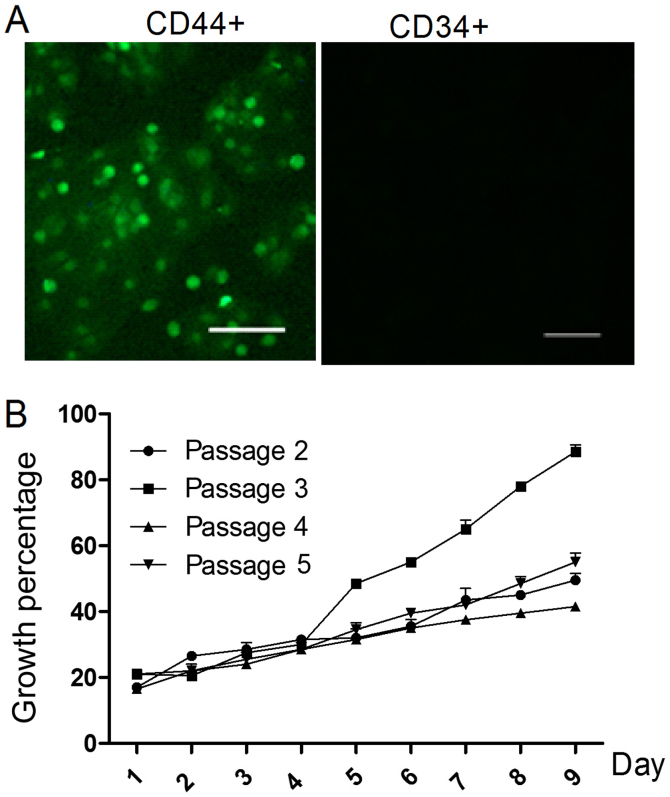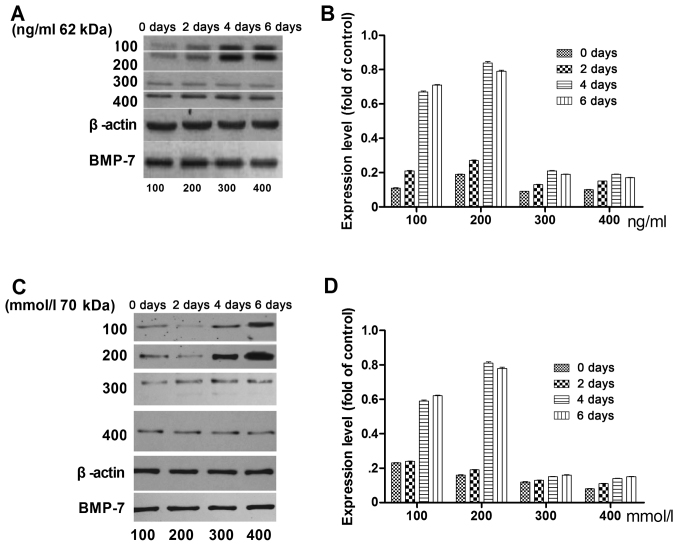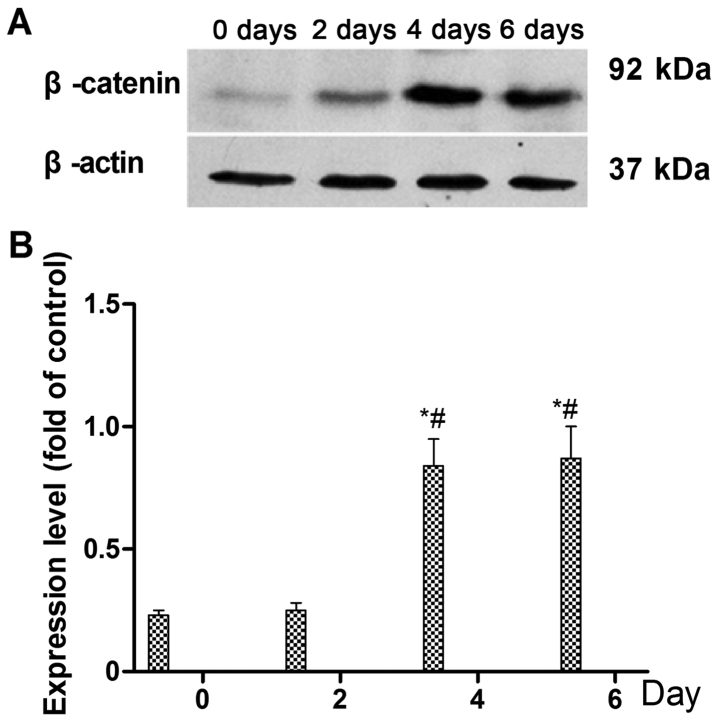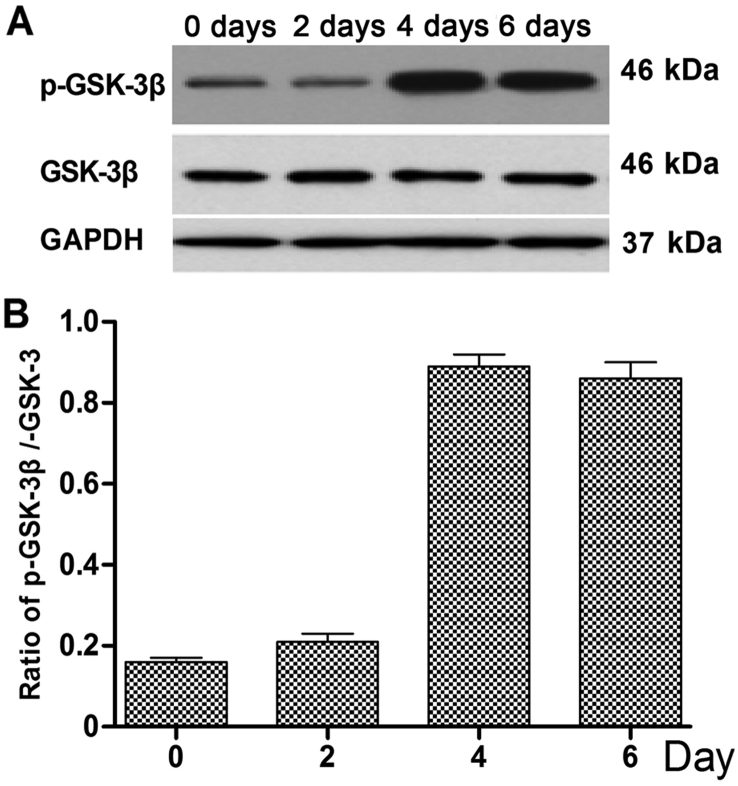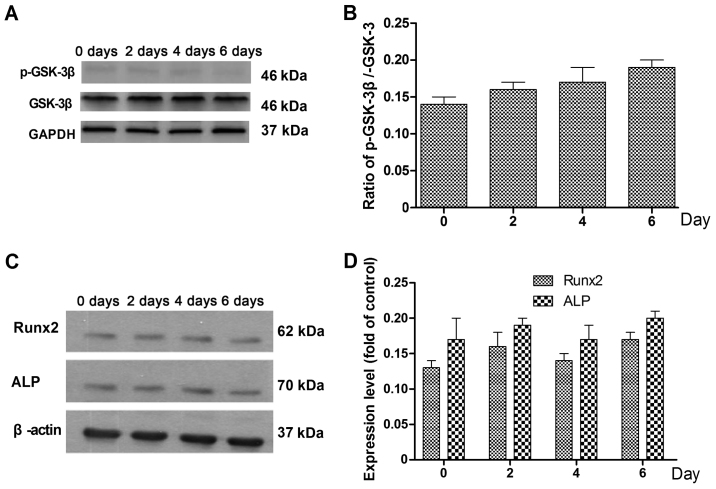Abstract
Mesenchymal stem cells (MSCs) are able to differentiate into adipocytes, chondroblasts or cartilage under different stimulation conditions. Identifying a mechanism that triggers the differentiation of MSCs into cartilage may help the development of novel therapeutic approaches for heterotopic ossification, the pathological formation of lamellar bone in soft tissue outside the skeleton that may lead to debilitating immobility. Bone morphogenetic proteins (BMPs), including BMP-7, are the most potent growth factors for enhancing bone formation. The current study aimed to understand the potential involvement of the Wnt/β-catenin signaling pathway in the BMP-7-induced growth of rabbit MSCs (rMSCs). Different concentrations of BMP-7 were applied to cultured rMSCs, and proliferation was evaluated by MTT assay. Changes in the phosphorylation state of glycogen synthase kinase (GSK)-3β, in addition to the expression levels of alkaline phosphatase, β-catenin and runt-related transcription factor 2 were observed by western blot analysis. Following treatment with BMP-7, the phosphorylation of GSK-3β was stimulated and the expression of β-catenin, ALP and Runx2 was increased. Furthermore, inhibiting β-catenin signaling with XAV-939 suppressed the BMP-7-mediated changes. The results indicated that the BMP-7-induced differentiation of rMSCs into cartilage was promoted primarily by the Wnt/β-catenin pathway.
Keywords: rabbit mesenchymal stem cells, bone morphogenetic protein-7, differentiation, Wnt/β-catenin, cartilage
Introduction
Heterotopic ossification is the pathological formation of lamellar bone in the soft tissue outside the skeleton (1). Heterotopic ossification occurs frequently following severe head injury, spinal injury, non-traumatic intracranial lesions and long-term coma, and the etiology of heterotopic ossification has been classified as neurogenic, traumatic and hereditary (2). It is a debilitating condition as soft tissues, such as muscle, tendon and ligaments convert into cartilage and bone, leading to immobility (3). Heterotopic ossification typically occurs following severe head injury, spinal injury, non-traumatic intracranial lesion and long-term coma. However, the occurrence of excessive, symptomatic heterotopic ossification bilaterally around the hips and knees is rarely described in the literature (2).
In the recovery from articular cartilage injury, the cartilage exhibits little capacity for self-repair and regeneration (4). Bone marrow-derived mesenchymal stem cells (BMSCs) are able to facilitate the regeneration of cartilage (5). Studies using animal models have demonstrated that transplanted BMSCs are able to improve the repair of damaged bone, tendons and ligaments in vivo (6,7).
The most potent growth factors for enhancing bone formation are the bone morphogenetic proteins (BMPs), including BMP-7 and BMP-2 (8). BMP-7 induces osteoblast-like genes and matrix mineralization in primary mesenchymal stem cell (MSC) cultures. The appropriate biological and mechanical properties of scaffold materials are important in the attachment and differentiation of MSCs (9).
Wnt/β-catenin signaling is activated following the binding of Wnt ligands to the frizzled family of receptors (10). β-catenin signaling helps to regulate the differentiation of pluripotent stem cells into the cartilage lineage during fracture healing (11). Wnt signaling regulates the development of cartilage from MSCs and improves the efficiency of bone tissue engineering. Fromigue (12) previously demonstrated that the Wnt signaling pathway was involved in strontium-induced proliferation and differentiation of murine cartilage.
As Wnt/β-catenin signaling is important in cartilage development, the present study supplemented the cartilage differentiation culture media of rabbit MSCs (rMSCs) with BMP-7 to activate Wnt/β-catenin signaling. The results of the current study provide novel insights into the mechanism by which BMP-7 regulates the differentiation of MSCs into cartilage through the Wnt/β-catenin signaling pathway.
Materials and methods
Reagents
BMP-7 was purchased from Sigma-Aldrich (Merck KGaA, Darmstadt, Germany). Antibodies targeting β-actin (cat no. 12262), GAPDH (cat no. 5174) alkaline phosphatase (ALP; cat no. 8681), runt-related transcription factor 2 (Runx2; cat no. 8486), cluster of differentiation (CD)34 (cat no. 3569), CD44 (cat no. 3516), β-catenin (cat no. 11887), glycogen synthase kinase 3β (GSK3β; cat no. 94331) and phosphorylated-GSK3β (cat no. 9322) and peroxidase-conjugated secondary antibody against immunoglobulin (Ig)G (cat no. 9087) were purchased from Cell Signaling Technology, Inc. (Danvers, MA, USA). β-catenin signaling inhibitor XAV-939 was purchased from Sigma-Aldrich (Merck KGaA).
Isolation and culture of rMSCs
The rMSCs were obtained from a male neonatal New Zealand white rabbit (0.75 kg, 1 month old). Rabbits were allowed free access to food and water at 25°C and 50–60% humidity with a 12 h light/dark cycle. The rabbit was purchased from Vital River Laboratory Animal Technology Co., Ltd. (Beijing, China). The present study was carried out in strict accordance with the Guidelines on the Care and Use of Laboratory Animals issued by the Chinese Council on Animal Research and the Guidelines of Animal Care. Bone marrow (32 ml) was aspirated from the iliac crest of the rabbit following sacrifice. The bone marrow was flushed with low glucose Dulbecco's modified Eagle's medium (DMEM; Gibco; Thermo Fisher Scientific, Inc., Waltham, MA, USA) using a 1-ml syringe. The bone marrow-PBS mixture (8 ml) was centrifuged for 5 min at 1,200 × g and 20°C (Labofuge 400R; Thermo Fisher Scientific, Inc.) and the supernatant was removed. Pellets were washed with PBS (8 ml) and centrifuged at 1,200 × g again. The resultant cells were plated in a culture dish, and incubated at 37°C with 5% CO2 for 4 days. The animal protocol was approved by the Inner Mongolia Medical University Experimental Animal Management Committee (Inner Mongolia, China).
3-(4,5-Dimethylthiazol-2-yl)-2,5-diphenyltertrazolium bromide (MTT) assay
To determine the cell growth percentage, an MTT assay was performed. Cells were subsequently divided into the following groups: Control cells and BMP-7-treated cells (final concentration 400, 500, 600, 700 or 800 ng/ml). Cells in the BMP-7 groups were grown in 96-well plates (1×103 cells/well, 37°C for 1, 2, 3, 4, 5 and 6 days) supplemented with different concentrations of BMP-7 (400, 500, 600, 700 or 800 ng/ml). Control cells were stored in DMEM containing 0.1% dimethyl sulfoxide (DMSO). At 1, 2, 3, 4, 5 and 6 days following BMP-7 treatment, a total of 20 µl of MTT was added to each well to give final concentration of 0.5%. Cells were incubated for 4 h at 37°C in the dark and 150 µl DMSO was added to each well for 10 min to dissolve the formazan crystals. The absorbance was measured using a microplate reader (EXL800; Cole-Parmer, Vernon Hills, IL, USA) at 490 nm. All experiments were repeated three times. The viability of the BMP-7 treated cells was expressed as the percentage of population growth plus the standard error of the mean relative to that of untransfected control cells. Cell growth was calculated as follows: growth percentage = (mean experimental absorbance-mean control absorbance)/mean control absorbance ×100.
Immunofluorescence
The rMSCs, were fixed in 3.7% paraformaldehyde at room temperature for 30 min. rMSCs were then blocked with 1% bovine serum albumin (Hyclone; GE Healthcare Life Sciences, Logan, UT, USA) in PBS with 10% goat serum (Sigma-Aldrich; Merck KGaA) overnight at 4°C. The samples were subsequently incubated with primary antibodies (CD44, 1:500, and CD34, 1:800) diluted in PBS at 37°C for 2 h. Primary antibody binding was detected using an IgG (H+L) secondary antibody (cat no. 9087; 1:2,000; Cell Signaling Technology, Inc.) at 37°C for 1 h. The fluorescence images were captured using a fluorescence microscope.
Western blot analysis
Total proteins were extracted from rMSCs using a Beyotime Cell Protein Extraction kit (Beyotime Institute of Biotechnology, Haimen, China) according to the manufacturer's protocol. Proteins (20 µg) were separated by 12% SDS-PAGE and transferred to nitrocellulose membranes for immunoblotting. Membranes were blocked with 5% fat-free milk for 30 min at room temperature in PBS buffer containing 0.1% Tween-20, and subsequently incubated with primary antibodies against β-actin (1:2,000), ALP (1:800), Runx2 (1:1,000), β-catenin (1:1,500), GSK3β (1:1,000) and phosphorylated-GSK3β (1:8,00) overnight at 4°C. The membranes were subsequently washed three times with PBS, and then incubated with peroxidase-conjugated secondary antibodies IgG (cat no. 9087; 1:4,000; Cell Signaling Technology, Inc.) at 37°C for 1 h. ECL reagents were used to visualize the results (Pierce; Thermo Fisher Scientific, Inc.; cat no. 32132).
Cartilage differentiation
The rMSCs were plated at a density of 5,000 cells/cm2 and exposed to standard differentiation-inducing media (cat no. D4902; Sigma-Aldrich; Merck KGaA) for 21 days. The medium (10 mg/ml transforming growth factor b1 and BMP-7) was refreshed twice per week. Cartilage differentiation was achieved following standard in vitro protocols (13). Endothelial differentiation was stimulated by culturing the cells in endothelial growth medium-2 (Sigma-Aldrich; Merck KGaA) at 37°C for 2 h.
Statistical analysis
One-way analysis of variance was used to complete the statistical analysis with GraphPad Prism version 5 software (GraphPad Software, La Jolla, CA, USA). Unpaired Student's t-tests were used as appropriate to evaluate the statistical significance of differences between two group means. Data are presented as the mean ± standard deviation. P<0.05 was considered to indicate a statistically significant difference.
Results
Identification of rMSCs
The morphology of the rMSCs was observed using a microscope. On day 10, cells reached 80% confluence. To identify the rMSCs, the expression of CD34 and CD44 was evaluated. Observation under a fluorescence microscope detected no expression of CD34, but CD44 was observed as green fluorescence (Fig. 1A).
Figure 1.
Identification of rMSCs. (A) Immunofluorescence of cell markers, CD44 and CD34, in cultured rMSCs. Scale bar, 25 µm. (B) Cellular proliferation during the second to fifth cell passages (as determined at an absorbance of 570 nm). CD, cluster of differentiation; rMSCs, rabbit mesenchymal stem cells.
From the second to the fifth cell passages, the growth status was analyzed. As presented in Fig. 1B, the cells demonstrated the greatest ability to proliferate in the third passage (P<0.05).
Optimal concentration and time for BMP-7-induced effects on the differentiation of rMSCs into cartilage
The optimal concentration and application time of BMP-7 in the differentiation of rMSCs into cartilage were investigated. Fig. 2 presents the expression levels of Runx2 (Fig. 2A) and ALP (Fig. 2B) on days 0, 2, 4 and 6 with BMP-7 concentrations of 100, 200, 300, and 400 ng/ml. The highest expression level for both Runx2 and ALP was observed on day 4 with 200 ng/ml BMP-7.
Figure 2.
Effect of differing concentrations of BMP-7 on the expression of Runx2 and ALP protein with 0, 2, 4 and 6 days of BMP-7 treatment. (A) Western blot of Runx2 and (B) expression levels (gray scale values) of Runx2. (C) Western blot of ALP and (D) expression levels (gray scale values) of ALP. BMP-7, bone morphogenetic protein-7; Runx2, runt-related transcription factor 2; ALP, alkaline phosphatase.
BMP-7 promotes the differentiation of rMSCs into cartilage via the Wnt/β-catenin pathway
To identify the signaling pathway through which BMP-7 acts to promote the differentiation of rMSCs into cartilage, cells were treated with 200 ng/ml of BMP-7 for 0, 2, 4 and 6 days, and the expression level of β-catenin was examined by western blotting on days 0, 2, 4 and 6 (Fig. 3A). The results shown in Fig. 3B indicate that the expression of β-catenin was significantly increased on day 4 and 6, compared with that on days 0 and 2 (P<0.05; Fig. 3B). The phosphorylation of GSK-3β was also detected by western blotting (Fig. 4A), and was found to be increased on days 4 and 6 compared with days 0 and 2 (Fig. 4B).
Figure 3.
Expression of β-catenin protein following 0, 2, 4 and 6 days of bone morphogenetic protein-7 treatment. (A) Western blot of β-catenin and (B) expression levels (gray scale values) of β-catenin. *P<0.05 vs. day 0, #P<0.05 vs. day 2.
Figure 4.
Expression of p-GSK3β (ser9) and GSK3β protein levels following 0, 2, 4 and 6 days of 200 ng/ml BMP-7 treatment. (A) Western blot analysis of p-GSK3β (ser9) and GSK3β expression and (B) expression levels (gray scale values) of p-GSK3β/GSK3β expression. GSK3β, glycogen synthase kinase 3β; p, phospho; BMP-7, bone morphogenetic protein-7.
To verify that BMP-7 promotes the differentiation of rMSCs into cartilage via the Wnt/β-catenin pathway, the β-catenin signaling inhibitor XAV-939 (1.0 µM) was used to inhibit Wnt/β-catenin activity. Following the addition of XAV-939, the cells were treated with BMP-7 for 0, 2, 4 and 6 days. The phosphorylation of GSK-3β in the presence of XAV-939 (Fig. 5A and B) was decreased compared with that measured in the absence of XAV-939. In addition, the expression levels of ALP and Runx2 were also decreased in the presence of XAV-939 (Fig. 5C and D) compared with those in its absence.
Figure 5.
Effect of β-catenin signaling inhibitor XAV-939 on rMSCs. (A) Western blot analysis demonstrating the expression levels of p-GSK3β (ser9) and GSK3β. (B) Expression levels (gray scale values) for p-GSK3β/GSK3β. (C) Protein expression levels of Runx2 and ALP, determined by western blot analysis. (D) Expression levels (gray scale values) for the expression level of Runx2 and ALP. rMSC, rabbit mesenchymal stem cells; GSK3β, glycogen synthase kinase 3β; p, phospho; Runx2, runt-related transcription factor 2; ALP, alkaline phosphatase.
Discussion
Identification of a trigger for the differentiation of rMSCs into cartilage may assist the development of novel therapeutic approaches for the treatment of heterotopic ossification (14). The present study demonstrates that BMP-7 promoted the differentiation of rMSCs into cartilage via the Wnt/β-catenin pathway.
The CD44 and CD34 markers to identify the rMSCs were verified via immunofluorescence (15). Observation under a fluorescence microscope indicated that there was no expression of CD34, whereas CD44 was clearly expressed. Cell surface markers are key to identifying BMSCs (16). The BMSC preparations in the present study were positive for CD44 and negative for hematopoietic markers and endothelial markers such as CD34. Immunofluorescence confirmed that all cells were positive for expressions of CD44 and negative for CD34, thus confirming BMSCs. The optimal BMP-7 concentration and application time for the differentiation rMSCs into cartilage in vitro was investigated, and was found to be 200 ng/ml BMP-7 with 4 days incubation.
Furthermore, the mechanism and signaling pathway by which BMP-7 promotes the differentiation of rMSCs was evaluated. The Wnt/β-catenin pathway serves an important role in cell activity (15). The results suggested that BMP-7 promoted rMSC differentiation via the Wnt/β-catenin pathway. Following 4 days of treatment with BMP-7 (200 ng/ml), phosphorylation of GSK-3β was stimulated and the expression of β-catenin, ALP and Runx2 was increased. Previous studies have reported that PI3K-activated Akt is able to phosphorylate GSK-3β at Ser9, thereby inactivating GSK-3β and triggering related signaling pathways (17,18). Furthermore, inhibiting β-catenin signaling with XAV-939 suppressed the BMP-7-mediated changes observed in the rMSCs. In recent years, GSK-3β has been reported to serve important roles in regulating osteoblast differentiation (17). Several researchers have shown that inhibition of GSK-3β promotes osteogenic differentiation of mesenchymal progenitors but not adipogenic differentiation (17) and found that GSK-3β inactivation upon receptor activator of NF-kB ligand (RANKL) stimulation is crucial for osteoclast differentiation (18). The present study has limitations. For instance, only the Wnt/β-catenin pathway was considered; future studies should investigate additional cell pathways. The results of the present study demonstrate that BMP-7 accelerates the differentiation of rMSCs into cartilage via the Wnt/β-catenin pathway. These findings may provide a basis for the development of BMP-7 treatments for patients with cartilage degeneration.
Acknowledgements
This study was supported by the Natural Science Foundation of Inner Mongolia of China (grant no. 2014MS08103).
References
- 1.Alport B, Horne D, Burbridge B. Heterotopic ossification of the quadratus lumborum muscle. J Radiol Case Rep. 2014;8:41–46. doi: 10.3941/jrcr.v8i1.1348. [DOI] [PMC free article] [PubMed] [Google Scholar]
- 2.Convente MR, Wang H, Pignolo RJ, Kaplan FS, Shore EM. The immunological contribution to heterotopic ossification disorders. Curr Osteoporos Rep. 2015;13:116–124. doi: 10.1007/s11914-015-0258-z. [DOI] [PMC free article] [PubMed] [Google Scholar]
- 3.Edwards DS, Clasper JC. Heterotopic ossification: A systematic review. J R Army Med Corps. 2015;161:315–321. doi: 10.1136/jramc-2014-000277. [DOI] [PubMed] [Google Scholar]
- 4.Zheng H, Martin JA, Duwayri Y, Falcon G, Buckwalter JA. Impact of aging on rat bone marrow-derived stem cell chondrogenesis. J Gerontol A Biol Sci Med Sci. 2007;62:136–148. doi: 10.1093/gerona/62.2.136. [DOI] [PubMed] [Google Scholar]
- 5.Tang C, Jin C, Du X, Yan C, Min BH, Xu Y, Wang L. An autologous bone marrow mesenchymal stem cell-derived extracellular matrix scaffold applied with bone marrow stimulation for cartilage repair. Tissue Eng Part A. 2014;20:2455–2462. doi: 10.1089/ten.tea.2013.0464. [DOI] [PMC free article] [PubMed] [Google Scholar]
- 6.Shi J, Zhang X, Zeng X, Zhu J, Pi Y, Zhou C, Ao Y. One-step articular cartilage repair: Combination of in situ bone marrow stem cells with cell-free poly(L-lactic-co-glycolic acid) scaffold in a rabbit model. Orthopedics. 2012;35:e665–e671. doi: 10.3928/01477447-20120426-20. [DOI] [PubMed] [Google Scholar]
- 7.Maeda S, Fujitomo T, Okabe T, Wakitani S, Takagi M. Shrinkage-free preparation of scaffold-free cartilage-like disk-shaped cell sheet using human bone marrow mesenchymal stem cells. J Biosci Bioeng. 2011;111:489–492. doi: 10.1016/j.jbiosc.2010.11.022. [DOI] [PubMed] [Google Scholar]
- 8.Lavery K, Hawley S, Swain P, Rooney R, Falb D, Alaoui-Ismaili MH. New insights into BMP-7 mediated osteoblastic differentiation of primary human mesenchymal stem cells. Bone. 2009;45:27–41. doi: 10.1016/j.bone.2009.03.656. [DOI] [PubMed] [Google Scholar]
- 9.Burastero G, Scarfì S, Ferraris C, Fresia C, Sessarego N, Fruscione F, Monetti F, Scarfò F, Schupbach P, Podestà M, et al. The association of human mesenchymal stem cells with BMP-7 improves bone regeneration of critical-size segmental bone defects in athymic rats. Bone. 2010;47:117–126. doi: 10.1016/j.bone.2010.03.023. [DOI] [PubMed] [Google Scholar]
- 10.Aguilar JS, Begum AN, Alvarez J, Zhang XB, Hong Y, Hao J. Directed cardiomyogenesis of human pluripotent stem cells by modulating Wnt/β-catenin and BMP signalling with small molecules. Biochem J. 2015;469:235–241. doi: 10.1042/BJ20150186. [DOI] [PubMed] [Google Scholar]
- 11.de Boer J, Siddappa R, Gaspar C, van Apeldoorn A, Fodde R, van Blitterswijk C. Wnt signaling inhibits osteogenic differentiation of human mesenchymal stem cells. Bone. 2004;34:818–826. doi: 10.1016/j.bone.2004.01.016. [DOI] [PubMed] [Google Scholar]
- 12.Fromigué O, Marie PJ, Lomri A. Bone morphogenetic protein-2 and transforming growth factor-beta2 interact to modulate human bone marrow stromal cell proliferation and differentiation. J Cell Biochem. 1998;68:411–426. doi: 10.1002/(SICI)1097-4644(19980315)68:4<411::AID-JCB2>3.0.CO;2-T. [DOI] [PubMed] [Google Scholar]
- 13.Culbert AL, Chakkalakal SA, Theosmy EG, Brennan TA, Kaplan FS, Shore EM. Alk2 regulates early chondrogenic fate in fibrodysplasia ossificans progressiva heterotopic endochondral ossification. Stem Cells. 2014;32:1289–1300. doi: 10.1002/stem.1633. [DOI] [PMC free article] [PubMed] [Google Scholar]
- 14.Kara M, Ekiz T, Öztürk GT, Onat ŞŞ, Özçakar L. Heterotopic Ossification and Peripheral Nerve Entrapment: Ultrasound is a Must-use Imaging Modality. Pain Med. 2015;16:1643–1644. doi: 10.1111/pme.12749. [DOI] [PubMed] [Google Scholar]
- 15.Zhang LL, Liu JJ, Liu F, Liu WH, Wang YS, Zhu B, Yu B. MiR-499 induces cardiac differentiation of rat mesenchymal stem cells through wnt/β-catenin signaling pathway. Biochem Biophys Res Commun. 2012;420:875–881. doi: 10.1016/j.bbrc.2012.03.092. [DOI] [PubMed] [Google Scholar]
- 16.Zhang W, Zhang F, Shi H, Tan R, Han S, Ye G, Pan S, Sun F, Liu X. Comparisons of rabbit bone marrow mesenchymal stem cell isolation and culture methods in vitro. PLoS One. 2014;9:e88794. doi: 10.1371/journal.pone.0088794. [DOI] [PMC free article] [PubMed] [Google Scholar]
- 17.Wang Q, Cai J, Cai XH, Chen L. miR-346 regulates osteogenic differentiation of human bone marrow-derived mesenchymal stem cells by targeting the Wnt/β-catenin pathway. PLoS One. 2013;8:e72266. doi: 10.1371/journal.pone.0072266. [DOI] [PMC free article] [PubMed] [Google Scholar]
- 18.Kramer I, Halleux C, Keller H, Pegurri M, Gooi JH, Weber PB, Feng JQ, Bonewald LF, Kneissel M. Osteocyte Wnt/beta-catenin signaling is required for normal bone homeostasis. Mol Cell Biol. 2010;30:3071–3085. doi: 10.1128/MCB.01428-09. [DOI] [PMC free article] [PubMed] [Google Scholar]



